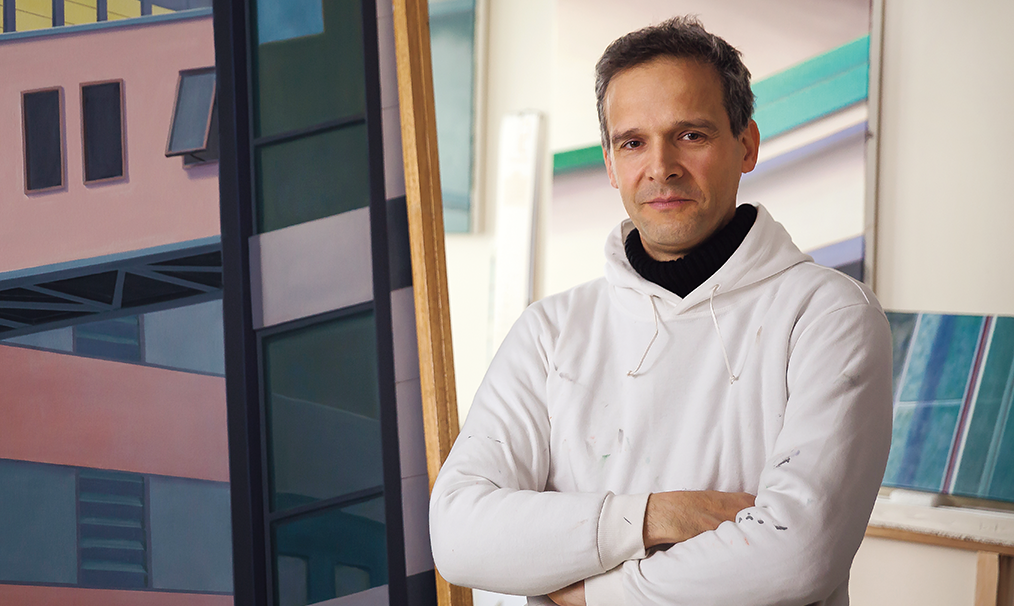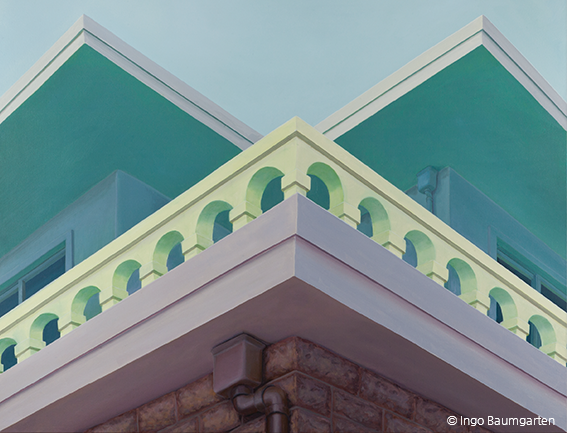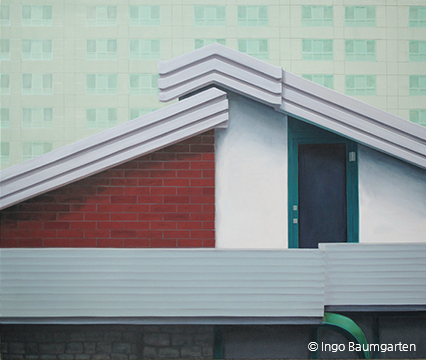Most local viewers of Ingo Baumgarten’s exhibitions probably can’t help but question the subject of his paintings. But they leave not only recalling long-forgotten sights but also with a renewed sense that old familiar scenes can be amusing and refreshing.

Ingo Baumgarten considers architecture a cultural product embodying local history and humanistic characteristics.
He brings to the canvas his interest in Korean middle-class “Western” housing built during the nation’s industrialization in the 1970s to the 1990s, which spearheaded rapid economic growth.
At first blush, Ingo Baumgarten does not exactly seem enamored with living in Korea. The German painter-cum-professor rarely mingles with others, Korean or otherwise. This indifference might stem from the time of his first glimpse of Korea in 1993, when Baumgarten came as an art student to see the Daejeon Expo. He was unimpressed.
“Most buildings were newly built, shiny and large. Their scale and uniformity reminded me of some Eastern European countries, like Hungary,” he recalls. “Equally strange were the numerous domestically produced cars that filled the streets here. There were few foreign vehicles on the road.”
Baumgarten’s feelings changed after he married a Korean woman, began teaching at a university, and settled in Seoul in 2008. The non-smoker and sparing drinker still largely secludes himself, devoting most of his free time to his wife and son. But now he loves many things Korean, from its nature to its foods. Praising the infrastructure of Seoul as “extremely good,” Baumgarten finds his life here “quite comfortable, in spite of the immense number of people.” And despite the permanent threat of war with North Korea, he feels rather safe because there are few crimes and violent incidents, unlike in some European countries or the United States.
Job security, public safety, personal comfort and convenience may be important factors when deciding where to live. However, it takes more than satisfying those conditions to keep a serious artist and art theorist like Baumgarten in Korea for over a decade. For him, the nation’s cultural and historical characteristics are pivotal.
Baumgarten lives near Hongik University, where he teaches painting as an assistant professor. The surrounding area is called “Hongdae,” the Korean acronym of the university. It is one of Seoul’s hottest districts for young fun-seekers, both Korean and foreign. However, what’s keeping the quiet, soft-spoken and thoughtful painter here, aside from commuting convenience, are neither the tourist hotspots nor the throngs of people crowding the area. Stimulating his artistic interest is something beyond most people’s assumption.
Why the Yangok houses?
It is concrete one- or two-story dwellings - the yangok(“Western-style houses”) mainly built between the 1970s and 1990s. Featuring three to five bedrooms, yangok reflected the self-confidence and optimism of middle-class families during Korea’s postwar economic growth. Now they are archaic reminders of that time. Mostly found in old and sometimes shabby residential areas such as the Mapo District in western Seoul, they contrast sharply not only with hanok, traditional Korean houses, but also with the capital’s affluent neighborhoods and the luxury apartments in the upscale Gangnam district.
Baumgarten has more than a few reasons for his fixation on yangok. His rationale, above all, revolves around the central principle of his artistic pursuit: discovering material in the panorama of one’s daily routine. That explains why he has little, if any, interest in Korea’s famous traditional houses and temples, or modern architectural landmarks. He walks around his neighborhood in Seogyo-dong, and nearby Hapjeong-dong and Sangsu-dong, observing the dandok jutaek, or detached single-family homes distinct from flat houses that are prevalent in Korean cities. When he finds certain structures - not just houses but also bridges, schools or subway stations - aesthetically inspiring, he photographs or draws them for use as future subjects in his paintings.
Another reason he cites sounds somewhat ironic. Most Koreans regard yangok as Westernized homes. In Baumgarten’s eyes, however, these homes couldn’t be more uniquely Korean. “Yes, the builders and homeowners apparently wanted to introduce American elements, such as terraces and gardens,” he says. “Still, most yangok retain traditional Korean architectural elements, including curved lines and a heavy emphasis on the main gates.” Fusions, more often than not, end up being a blend of two styles or a reflection of neither. While many local critics regard these homes as the latter, Baumgarten thinks otherwise. Indeed, Koreans are often accused of blindly adoring foreign things and neglecting their own cultural assets. Baumgarten believes yangok are another example of such misplaced admiration.
Visual Anthropology
Beyond pure aesthetics, there are different - and deeper - contexts underlying Baumgarten’s favorite subject matter. The single core concept sustaining his decades-long career - he has studied and worked in Germany, France and Britain, and then in Japan, Taiwan and Korea - is “visual anthropology,” which he defines as the “exploration of everyday life, culture and society through participant observation and their transformation into images and artworks.”
Throughout his study and work over the past 30-odd years, Baumgarten has tried to remain relevant by connecting his work to society and reality. “While anthropology studies everything about human beings, visual anthropology focuses on artifacts and visually perceptible effects of human behavior,” he adds.
“If my paintings depicting such buildings or their details bring back some memories among Korean viewers, or if they change their views of such houses even slightly, I am satisfied.”

“Untitled” (sulphur yellow balcony, Seogyo-dong, Seoul), 2012–2013, oil on canvas, 100 x 120 cm.
Stressing that he observes and analyzes the motifs of his paintings with a certain “ambivalent distance,” as a passerby without being involved, Baumgarten says that he tries to describe and present them without making judgments. But he recognizes that is not entirely possible.
“I am well aware that complete iveness is an illusion, so I do not hide my sympathy for yangok architecture. But I don’t want my paintings to look as if they are crying for help, or petitioning for rescue and preservation,” he explains. “However, if my paintings depicting such buildings or their details bring back some memories among Korean viewers, or if they change their views of such houses even slightly, I am satisfied.”
Baumgarten has experienced different societies and cultures, and he now seeks to understand the socio-cultural qualities inherent in these private houses and their architectural concepts. For this artist, an urban building is not just a structure; it represents an individual, a group, and a culture. A house is far more than a mere space for habitation; it defines the lifestyle and values of its inhabitants.
Three Missing Elements

“Untitled” (jutaek gable, door, Seogyo-dong, Seoul), 2011, oil on canvas, 80 x 100 cm.
As visitors to his exhibitions will find, Baumgarten’s paintings are devoid of three elements: titles, human figures and (explicit) messages.
“I don’t like to depict human figures in my paintings because they will immediately dominate the entire image,” Baumgarten says. “If I include human figures, instead of helping the viewer feel the piece of reality I depict, it will make the relationship between the figures and their surroundings appear to be the element of main concern.”
He continues, “I do not want my artworks to be explicitly educational or instructive. In my works, I like to keep a certain level of ambivalence to leave some room for different opinions or interpretations from individual viewers.” His paintings are neither abstract nor figurative in style. He suggests that they be classified as “resistance art” in Western contemporary art theory.
“Tosomething new, one has to refuse to fit into conventions and traditions,” he asserts. “I did not want to paint nice pictures of conventional subjects like still-lives, landscapes or portraits, satisfying conservative expectations.
Nor did I want to blindly follow the avant-garde movements, which turned away from painting. I tried to build my position apart from those tendencies, based on my personal and original interests.”
Baumgarten received a bachelor’s degree at the State Academy of Fine Arts Karlsruhe (Staatliche Akademie der Bildenden Künste Karlsruhe) in Germany and a master’s degree in fine arts at the Tokyo University of the Arts. He then went on to study in France and the United Kingdom. Hongik University students in his “Similarities and Differences” class learn how to develop ideas.
“I try to teach Korean students Europe’s cultural roots and philosophical thoughts,” Baumgarten says. “Korean students have good talents and skills, but sometimes they don’t seem to know what they want to express.”
Different Approaches to Architecture
“I have been interested in understanding and analyzing, from the viewpoint of a European, how Korea has absorbed Western culture and industries and reflected them in its culture and lifestyle,” Baumgarten explains. For example, he finds noticeable differences between German and Korean approaches to architecture. “In Germany, they don’t build so many new houses, let alone buildings that do not harmonize with their surroundings. In my neighborhood alone, I have seen several houses torn down and rebuilt in less than a decade. And many relatively new homes, including yangok, have also been remodeled amid the phenomenon of gentrification.”
This may explain Baumgarten’s enthusiastic adherence to what many Koreans regard as a transient urban housing style. It also illuminates why Koreans experience a kind of “culture shock” when they see a foreign artist breathing new life into scenes from their all too familiar surroundings. It would not be surprising if they were grateful to him for recording and preserving scenes that few Korean artists have depicted in such a unique and charming style.
“In my paintings, whether depicting buildings or not, I try to observe the actual currents of the contemporary city,” Baumgarten says. “Like the city, my motifs are evolving, and hopefully, they reflect the life in the city with its contrasts, harmonies and combinations.”
That seems to be the way Baumgarten loves the country where he lives now. And Koreans may have to brace for another round of culture shock sooner or later.
Choi Sung-jinExecutive Editor, Korea Biomedical Review
Ahn Hong-beomPhotographer